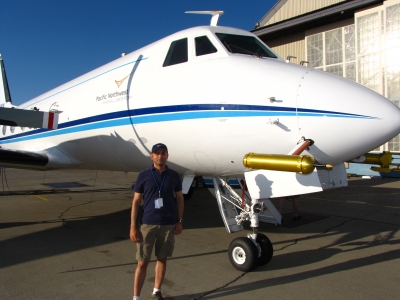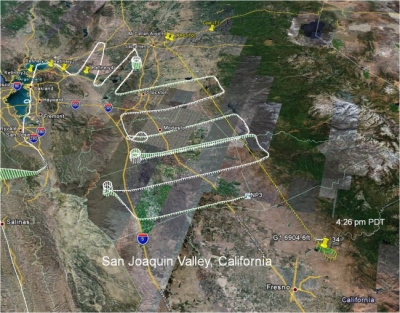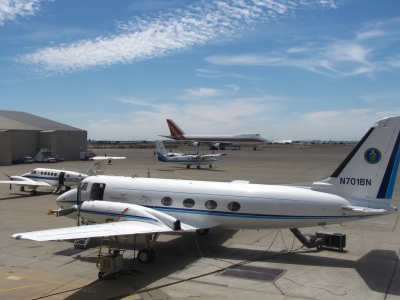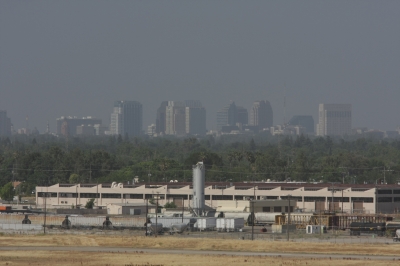Insights on modeling and reality from an air zone that mixes urban and natural influences

Who CARES? During June of 2010, a lot of people cared about the Carbonaceous Aerosols and Radiative Effects Study (CARES), a 26-day investigation of the composition, evolution, and fate of aerosols in an air transport region where both natural and urban emissions mix. The outdoor laboratory in this case was Sacramento, California, and its environs. The city shares an air transportation pathway with a largely uninhabited forest about 50 km downwind.
In a plus for scientists studying atmospheric chemistry, summertime wind patterns in the Sacramento area have a predictable “flow regularity,” said CARES principal investigator Rahul Zaveri, an atmospheric scientist at the Pacific Northwest National Laboratory (PNNL). “It was quite attractive for the kind of sampling we wanted to do.”
The site was just right for other reasons too.
“With urbanization happening the way it is, we’re encroaching upon natural regimes all the time,” said Jerome Fast, and so it’s important to understand how natural aerosols are affected by man-made varieties. Fast, a PNNL atmospheric scientist, was lead author of a 2014 regional modeling paper on CARES, and contributed significantly to the chemistry version of the widely used Weather Research and Forecasting model.
The Sacramento scenario used in CARES—an urban/rural air transport regime near a marine coast in summertime—is not universally applicable to all regions in climate models, but real-world data from the study will add to a cumulatively improving understanding of aerosols, and will ultimately improve climate models, he said.
“Part of the goal here was to publicly let modelers know there are data out there. It starts a little domino effect going,” shared Fast.
Taking Care of Data
Six years later, a lot of scientists still care about CARES. The study and its publicly archived data have inspired more than 30 papers, sparked 600-plus citations, and spurred a second generation of lab-based studies: Mostly air-chamber investigations trying to puzzle out some of the surprises to emerge from CARES.
One paper, for instance, by Laskin et al., observed that sea salt particles swept into the air 100 km from Sacramento survived in a form puzzlingly stripped of chloride.
“Overall, it’s a very comprehensive data set that people are still using,” said Zaveri. He was lead author on the CARES overview paper, and co-authored nine others.
The large number of papers so far marks the success of CARES, said study collaborator Beat Schmid, manager of the ARM Aerial Facility and associate director of PNNL’s Atmospheric Sciences and Global Change Division. Scientists plumbing the data set, he said, “are making excellent use of airborne and ground-based observations.”

During the study itself, those caring about CARES included investigators from all the collaborating entities: U.S. Department of Energy’s Atmospheric Radiation Measurement (ARM) Climate Research Facility, NASA, a dozen universities, and other national labs.
The ARM Aerial Facility deployed its Gulfstream-1 (G-1) research aircraft on 22 flights through the urban plume of pollutants welling into the air from Sacramento, and on across the Central Valley, to the sparsely inhabited foothills of the Sierra Nevada mountain range.
Research flights and ground-based instrumentation kept 60 technicians, engineers, pilots, and atmospheric scientists busy. Local students also got quick lessons in air quality and atmospheric chemistry. Near Sacramento’s urban core, CARES instruments were sited at American River College. The downwind site was located in rural terrain 52 km to the northeast of the city, where the study demonstrated science in action to K-8 students at the Northside School in eponymously named Cool, California.
Caring About Aerosols
Aerosols that contain carbon, the chief research target of CARES, are worth caring about too. These microscopic substances undergo chemical and physical changes as they disperse through air. They heavily influence cloud formation, the lifespan of clouds, and the Earth’s radiation balance—how much sunlight the planet either absorbs or reflects. At present, aerosols are one of the largest sources of uncertainty in global and regional climate models.
Aerosols are created either by natural or man-made sources, both of which were accounted for in the study. Sacramento, a mid-size metropolitan area, is upwind of a largely unpopulated area of pine and oak trees known as Blodgett Forest in the Sierra Nevada mountain range.
The same template of research terrain was also a good place to see how urban emissions evolved as they progressed from city to forest.
“Pollutants undergo many changes once they are emitted,” said Zaveri, hitting on the chemical and morphological mutability that makes climate prediction so challenging. “These particles grow and their properties change.”

During CARES, scientists took measurements of trace gases and aerosols. But they were mainly in pursuit of three airborne study targets: Black carbon, which emerges from tailpipes; and other man-made sources before evolving—“aging”—in the atmosphere; and primary organic aerosols (POA) directly emitted into the air from man-made sources like diesel exhaust, grill cooking, and biomass burning; and secondary organic aerosols (SOA).
“The most uncertain [POA] in terms of aerosol modeling,” said Fast. “We just don’t know enough from measurement about what’s actually going on. It’s hard to put something into a model if you can’t even fully explain the chemistry.”
SOAs come from both man-made and natural sources. Even without cities, he said, there would be SOAs, a by-product of the isoprene and terpenes being pumped into the atmosphere by forest settings the world over. But CARES research underlined a finding noted about other locations—biogenic SOAs from trees, when mixed with anthropogenic varieties, perturb the atmospheric chemistry and enhance biogenic production of SOA.
“It’s like you put lighter fluid on your charcoal grill,” said Fast. “You speed things up.”
“CARES”-Full Results
So far, some of the papers to emerge from CARES note that black carbon aerosols and its optical (light-scattering) properties are not well represented in current climate models.
Atmospheric black carbon, an irregularly shaped fractal product emitted from man-made sources like tailpipe emissions, warms the Earth’s climate and is a prominent target for climate change mitigation measures. Once emitted, it mixes with other aerosol components, which fill in its fractal irregularities to form sphere-like bodies that act like lenses and speed up heat absorption. Those “absorption enhancements” are thought to double the effect black carbon has on warming.
But one paper in Science (Cappa et al.) used direct in situ measurements from CARES to show that those enhancements to black carbon are more in the range of 6 percent, not 100 percent. Like many other CARES discoveries, the black carbon surprise has inspired lab-based studies of the aerosol’s optical properties.

Other papers inspired by CARES note that previous models tended to under-predict SOA formation in both the urban atmosphere and in the upper troposphere. It appears that mixing urban and natural emissions enhances SOA formation, “for reasons we don’t fully understand,” said Zaveri, echoing Fast. “But now we have more evidence of this phenomenon.”
One SOA paper (J.E. Shilling et al.) drew on evidence from ARM’s airborne measurements. The study used isoprene as its signature of natural emission. This organic compound, made by plants, globally accounts for about a third of hydrocarbons pulsed into the atmosphere. In the CARES study the primary source of isoprene was oak trees, which (like other trees) emit isoprene to cope with heat stress and other non-biological environmental pressures.
Another SOA paper (Vaden et al.) found that SOA evaporated much more slowly than models indicate, taking 10 to 20 hours to do so.
“That basically means we were modeling SOA incorrectly,” said Zaveri, who authored a 2014 paper proposing a new framework for modeling SOA.
The same CARES discovery about the lifespan of SOA in the atmosphere has inspired lab studies on viscosity: a liquid-like SOA would evaporate faster than a SOA that was “highly viscous and sticky,” said Zaveri.
That is still a controversial finding among SOA researchers even six years after the last CARES instrument was packed up for another ARM campaign.
“There are multiple pathways depending on where you are,” said Fast, whose belief is that there is a “regionality” to CARES climate data, just as there is to data gathered in Amazonia. And this “regionality,” he added, will become more important in future generations of climate model predictions.
The elusive chemistry of SOA chemistry is just one example of the need for a lot of data and observations, as in CARES, to make strides in atmospheric science. In the end, said Fast, the real answers will only come from the “net result of various campaigns.”
# # #
For more information about this study, read the PNNL highlight, “Why we care about carbonaceous aerosols,” and see the full list of papers.
For an inside look at the campaign, read Rahul Zaveri’s blog, written as the CARES experiment was going on.
# # #
The ARM Climate Research Facility is a national scientific user facility funded through the U.S. Department of Energy’s Office of Science. The ARM Facility is operated by nine Department of Energy national laboratories including the Pacific Northwest National Laboratory, which leads management of the ARM Aerial Facility.

